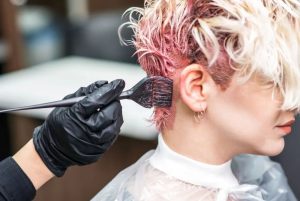Is coloring harmful to the skin
Hair coloring is a hit with many beauty enthusiasts and has become one of the hot ways to make up these days. There are a lot of hair coloring products available in the market, so how can we identify and use these hair coloring products safely? Let’s find out today.
What is the hair structure like?

First point:
The cross section of hair (hair shaft) can be divided into 3 parts from outside to inside, such as hair epidermis, hair cortex, and hair medulla, etc. The hair epidermis, also known as hair scales, etc., is the outermost layer of the hair shaft, and consists of scales or tile-like cells. The hair epidermis is rich in high sulfur proteins, which can resist the influence of external physical and chemical factors, and play a protective role in the internal structure of the hair. The structural integrity of the hair epidermis directly determines the health of the hair.
Point two:
The hair cortex is tightly wrapped around the medulla, which is the main component of the hair shaft, and the number of cortical fibers directly determines the thickness of the hair. In addition, the cortical cell matrix contains pigment granules – true melanin and melanoidin, true melanin is black or brown and melanoidin is yellow or red. The type and amount of pigment granules directly determine the color of the hair. The medulla is located in the center of the hair shaft and has numerous air holes within it. These air-filled pores serve as heat insulators while increasing the strength and rigidity of the hair. In contrast to animal hair, the human medulla is usually amorphous and its main task is to protect the head from direct ultraviolet radiation. In addition to this, the interior of the hair contains internal lipids, mainly located between the cells of the hair epidermis and in the gaps between the hair epidermis and cortical cells, called cell membrane complexes, which ensure cohesion between the cells.
Is hair coloring harmful?

01
Hair dyes are classified into temporary, semi-permanent and permanent hair dyes according to the duration of the coloring of the hair. According to the principle of hair coloring, they can be divided into oxidizing hair dyes and non-oxidizing hair dyes. At present, most of the hair dyes used in daily life are oxidizing hair dyes. The principle of oxidative hair dye is to make the small molecule aniline colorant precursor and coupling agent penetrate into the loose hair, and then under the action of oxidizing agent oxidative polymerization reaction occurs, so as to generate large molecules of pigment that is not easy to detach from the hair, closed in the hair fiber, so that the hair long-term appearance of the corresponding color.
02
Most permanent hair dyes contain p-phenylenediamine, a coloring agent and a common ingredient that causes allergic reactions and is an internationally recognized carcinogen. During the process of hair coloring, the dye will inevitably come into contact with the skin, and the process of hair coloring often requires heating, the benzene organic substances may enter the body through the scalp, and then reach the bone marrow with the blood circulation, and repeatedly act on the hematopoietic stem cells over a long period of time, leading to malignant changes in the hematopoietic stem cells, and may even cause leukemia. In terms of the kidneys, it will lead to acute and chronic kidney disease, proteinuria, creatinine elevation, reduced urine output or even no clinical symptoms. In addition, hair dyes contain heavy metals such as lead and copper, which are also absorbed by the body through the scalp, and their excretion requires the kidneys, which is self-evidently harmful to the kidneys.
How to reduce the harm of hair coloring?

01
Do a topical skin sensitivity test
Regardless of whether you are using chemical or vegetable hair dyes, it is best to apply a small amount of hair dye to the back of the ear, inner arm, etc. for 72 hours before coloring your hair to observe if there is any allergy.
02
Don’t wash your hair before dyeing
Don’t wash your hair two days before you dye it, because after washing your hair, your scalp will become clean and the chemical dye will do more damage to your scalp. And the daily secretion of the scalp oil in the hair coloring can play a protective role for the scalp, isolate the scalp from the chemical dye, reduce the damage to the body.
03
Protect yourself when dyeing your hair
Try to avoid hair dye contact with scalp and facial skin, you should first apply lotion in the hairline, behind the ears, or wear special ear muffs for protection. If the skin is accidentally stained with hair dye, it should be wiped off immediately with petroleum jelly or face cream.
04
Wash more after hair coloring
In the cleaning session after the hair coloring, it is best to wash a few times to clean the hair dye, do not have residue on the scalp or hair. Do not color your hair if you have scratches on your scalp.

